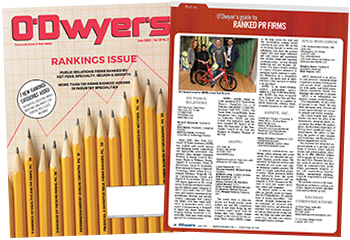 Brandon Stephenson Brandon Stephenson |
You can’t overstate the impact COVID-19 has had on every aspect of our lives: physical, emotional, financial. It has exasperated our hyper-partisan environment, brought our once-bustling economy to a grinding halt and created new barriers for our interconnected society. And just as individuals are responding to the pandemic and our altered reality differently, the same is true for the communications industry.
Firms specializing in serving tourism, recreation and hospitality clients have obviously seen a drastic reduction in revenue as these sectors have been devastated since travel restrictions and Safer at Home orders were put in place. Conversely, firms that have more of a diverse or different clientele—health care, natural resources, transportation, technology, infrastructure—are in a better position to weather the storm.
But even for those of us fortunate enough to be at firms that have been able to mitigate the impact of COVID-19 on its operations—or for those that have expanded their business—we’ve all had to make significant adjustments on the fly.
 |
| This article is featured in O'Dwyer's Jun. '20 PR Firm Rankings Magazine. |
Successful communications professionals and firms have had to quickly adapt to this new normal, changing how we approach the internal and external aspects of our operations. Rightfully so, there’s more of a focus on employee well-being and flexibility as part of ongoing retention and development programs. Client services and marketing efforts to secure new clients have taken on renewed importance as clients from all sectors tighten budgets and look to trim expenses. This is the new reality we find ourselves in. This is our new normal.
These two months have reaffirmed some foundations of successful communication programs; you must put yourselves in the shoes of your audience and understand their perceptions if you wish to truly reach them, and you must be prepared for whatever situation might arise as every organization finds itself on the front lines.
Understanding your audience
Our formula is tried and true: determine the best messages, messengers and delivery to engage our target audiences, educating them, influencing them, motivating them toward a certain action or position. It has always been and will continue to be about clearly and consistently communicating the “what’s in it for me” to make our clients’ issues relevant to our intended audience, making our issue their issue. But figuring out the “what’s in it for me” proposition in our new normal is radically different as people’s perceptions have changed.
Just think about what life was like in January. Unemployment was at historic lows, the stock market continued to reach new heights and consumer confidence was high. People now see things through the lens of a societal shift that we haven’t seen in decades, if not generations.
Recent polling by California-based survey research experts Fairbank, Maslin, Maullin, Metz & Associates details just how much COVID-19 is weighing on the minds of the public. Eighty-nine percent of respondents said the economic impact of coronavirus is an extremely serious/very serious problem, unsurprisingly outstripping issues that previously dominated surveys such as healthcare, housing and climate change. The same poll found that concerns about unemployment has shot up more than 24 percent in the last 12 months.
None of this should come as a surprise, but we must constantly remind ourselves that this is the mindset of the public and the concern of decision-makers that we’re ultimately trying to influence. We must tailor public relations and public affairs strategies to this current climate. Understand where your audience is now coming from—their concerns, stress and fears—when developing how and when you’ll communicate with them.
This is a delicate balancing act. Continue with your pre-coronavirus communications plan and you’ll look tone deaf, like the property management company posting a celebratory post about the first day of Spring on the same day Los Angeles County announced its Safer at Home order. But at the same time, people are experiencing fatigue from the wall-to-wall COVID coverage. While we always want to be mindful of the current situation, we also need to make sure we aren’t overwhelming anyone with coronavirus-related content nor can we get distracted from achieving the client’s goals.
Preparing for what’s next
Every day, you read about some COVID-19 crisis: a protest against government shelter orders, conflicts that spirals into confrontations at businesses that are trying to protect shoppers and employees, mass outbreaks of coronavirus at large employers’ worksites, workers demanding better protections and casting businesses in a negative light as being uncaring or unresponsive.
What’s amazing is how many businesses, regardless of size, still don’t have crisis communication plans, nor the trained team to implement those plans, in case of an incident that could hurt a company’s reputation. These companies risk having their story be told by someone else if they don’t rapidly deploy a program to providing timely and accurate information.
This goes without saying, but since so many people and organizations are unprepared it can never be stated enough: good crisis planning, preparation and execution, even in the middle of a pandemic, is vital. Companies that are ready to respond to various scenarios have the internal-consultant team in place who own the crisis communications plan, with messaging and trained spokesperson(s), ready to communicate rapidly and across a broad spectrum of channels.
This includes social media, which is still seen as an afterthought by too many traditional leaders and organizations. Sure, social media can be your best friend or your worst enemy. But in a time of crisis, it’s often the very first place people turn to get the latest information. Social media should be one of the first places you disseminate information. Use your social channels often, monitor and respond to comments, and push out essential information in a consistent and timely manner, just like you’d do with traditional press releases and press conferences.
You need to hope for the best but plan for the worst. We know that one day this pandemic will end. We hope it ends soon, but we have to plan that this new normal will last for the foreseeable future. And as our offices and conference rooms have become kitchen tables and Zoom virtual meetings, we still need to develop strategies and solutions to tackle complex problems. Through persuasive storytelling, understanding our audiences and being prepared to rapidly respond to crises, communications firms can continue to help our clients meet their goals.
***
Brandon Stephenson is Chief Strategic Officer with Cerrell Associates.


 There’s a fine line between newsjacking and taking advantage, aka ambulance chasing. Our job as PR professionals is to tread it carefully.
There’s a fine line between newsjacking and taking advantage, aka ambulance chasing. Our job as PR professionals is to tread it carefully. PR firms need to be mindful of ways their work product may be protected by the attorney-client privilege whenever working with a client’s internal legal team or its external legal counsel.
PR firms need to be mindful of ways their work product may be protected by the attorney-client privilege whenever working with a client’s internal legal team or its external legal counsel. Manuel Rocha, former US ambassador and intenational business advisor to LLYC, plans to plead guilty to charges that he was a secret agent for Cuba.
Manuel Rocha, former US ambassador and intenational business advisor to LLYC, plans to plead guilty to charges that he was a secret agent for Cuba. CEO mentoring is an often-overlooked aspect of why CEOs are able to make good decisions, and sometimes make bad ones—all of which intersects with the role and duties of a board.
CEO mentoring is an often-overlooked aspect of why CEOs are able to make good decisions, and sometimes make bad ones—all of which intersects with the role and duties of a board.  How organizations can anticipate, prepare and respond to crises in an increasingly complex world where a convergent landscape of global challenges, threats and risks seem to arrive at an unrelenting pace.
How organizations can anticipate, prepare and respond to crises in an increasingly complex world where a convergent landscape of global challenges, threats and risks seem to arrive at an unrelenting pace.


 Have a comment? Send it to
Have a comment? Send it to 
No comments have been submitted for this story yet.